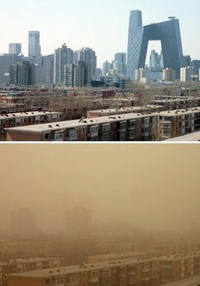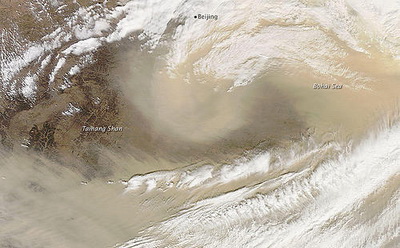How Can We Save Ourselves from Sandstorms?
Cover Editorial - EO print edition no. 462
Translated by Tang Xiangyang
Original article: [Chinese] How Can We Save Ourselves from Sandstorms?
How Can We Save Ourselves from Sandstorms?
Beijing has once again been struck by sandstorms, along with Fujian, Shanghai, Jiangsu, Zhejiang, Anhui, Sichuan and other provinces in Southern China. Even Taiwan, Japan and South Korea were affected. Although meteorological experts and officials with the Ministry of Forestry have mainly attributed the storm to natural factors, we should admit that humans are more to blame for the frequency of these sandstorms.
It is an indisputable fact that the number of sandstorms in China are increasing every year. In the 1950s, there were five; in the 1960s, eight; in the 1990s, twenty-three. And in a single year of 2000, there were over twenty sandstorms. From 2001 till 2010, sandstorms occurred every year; such an increased level of frequency can't simply be explained by meteorological factors.
Experts have found that the sand from the storms is not from the central deserts, but is primarily from the fringes of the desert, from abandoned farmland currently undergoing the process of desertification; a result of human activities.
Desertification has occurred in one third of China's land. Every year, land with an area equivalent to a mid-level county will become desert. The average speed of desertification is almost .75 acres per minute. Desertification brings about a direct economic loss of over 50 billion yuan to China per year. 400 million Chinese people are living under the threat of desertification and half of China's impoverished people live in these areas.
Desertification and poverty have a direct cause and effect correlation, which is especially true for Western China. To escape poverty, people have to clear land for cultivation, to graze herds and to develop industries, which leads to excessive logging. As the land is over used, desertification of areas is inevitable.
However for many people and local officials, although no one denies the importance of protecting the environment, the urgency of raising living standards far outweighs the need for maintaining a stable environment.
In the Inner Mongolian Autonomous Region, herdsman rely on raising cattle to make a living. All of the famous companies based in the area, including dairy giants Inner Mongolia Yili Industrial Group and China Mengniu Dairy Company Limited along with textile and clothing producer Erdos depend on the region's livestock for their business. Due to the importance of the cattle industry, the number of herds has far exceed the acceptable livestock density; in some areas the rate of overgrazing of pastures is over 300%.
Because Inner Mongolia is one of the sources of Beijing's sandstorms, many Beijingers are rushing there to plant trees. Some even want to cull the cattle in order to protect Beijing from sandstorms, but such extremism will not help curb the sandstorms.
We neither want the sandstorms to spread across China nor do we want to halt the rise in living standards of the people who depend on raising livestock for their living.
Is there any way to solve the problem? In the 1930s, the United States experienced far more sandstorms than we currently endure, because of the over-development of the Great Plains. However, after dozens of years of hard work, the plains became an important base of America grain production once more.
Aside from technological implementation, an important lesson to learn from the US experience is that from national legislation, the US turned a large amount of farming land back into grasslands which it then protected by zoning it as national parks.
Meanwhile, the US raised the living standards of the local people through various means so that they would not have to sacrifice their livelihood in order to protect the environment. Finally, the government educated citizens about environmental protection; allowing them to become independently aware about environmental concerns.
As China is about to carry out its second ten-year plan for the development of its western region, the occurrence of a "once every ten years" sandstorm should prompt us to reconsider our past economic growth model.
Restoring the beautiful western rivers and mountains once served as a resounding slogan of the national strategy of developing the western regions, but has since been forgotten.
It's more valuable to explore a development model for the western regions of China that's focused on ecological protection rather than GDP growth at all costs.
Of course, the central government needs to provide more subsidies for western regions to protect the local environment. If we can't make this our common plan for action, disasters similar to those predicted in the blockbuster 2012, will be waiting for us somewhere in the future.
Links and Sources
Pulitzer Center: "China's Growing Sands," an audio slideshow by Sean Gallagher
Yahoo: Sandstorm Slideshow
The views posted here belong to the commentor, and are not representative of the Economic Observer |




















